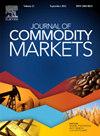Trading-hour and nontrading-hour volatility in crude oil and U.S. dollar markets and its implications for portfolio optimization
IF 4.5
4区 经济学
Q1 BUSINESS, FINANCE
引用次数: 0
Abstract
The covariance between crude oil prices and U.S. dollar exchange rates is crucial for energy investors, and stock prices differ between trading and nontrading hours. Thus, the present study uses a two-component generalized autoregressive conditional heteroskedasticity (GARCH) model to analyze whole-day returns. Our analysis of data from 2007 to 2021 reveals that trading-hour and nontrading-hour returns contain crucial information for modeling whole-day covariance. Additionally, out-of-sample portfolio comparisons indicate that a two-component model is more effective than simpler models for portfolio optimization, resulting in substantial basis point fees when switching from the static to the two-component model. Crucially, the economic value generated by the two-component model is not offset by reasonable transaction costs; more risk-averse investors can generate higher benefits.
原油和美元市场的交易时段和非交易时段波动性及其对投资组合优化的影响
原油价格和美元汇率之间的协方差对能源投资者来说至关重要,而股票价格在交易时间和非交易时间之间存在差异。因此,本研究采用双组分广义自回归条件异方差(GARCH)模型来分析全天收益。我们对2007年至2021年的数据进行了分析,发现交易时段和非交易时段的收益包含了全天协方差建模的关键信息。此外,样本外的投资组合比较表明,对于投资组合优化,双组分模型比简单模型更有效,当从静态模型切换到双组分模型时,会产生大量基点费用。关键是,双组分模型产生的经济价值没有被合理的交易成本所抵消;规避风险的投资者越多,收益越高。
本文章由计算机程序翻译,如有差异,请以英文原文为准。
求助全文
约1分钟内获得全文
求助全文
来源期刊

Journal of Commodity Markets
Multiple-
CiteScore
5.70
自引率
2.40%
发文量
53
期刊介绍:
The purpose of the journal is also to stimulate international dialog among academics, industry participants, traders, investors, and policymakers with mutual interests in commodity markets. The mandate for the journal is to present ongoing work within commodity economics and finance. Topics can be related to financialization of commodity markets; pricing, hedging, and risk analysis of commodity derivatives; risk premia in commodity markets; real option analysis for commodity project investment and production; portfolio allocation including commodities; forecasting in commodity markets; corporate finance for commodity-exposed corporations; econometric/statistical analysis of commodity markets; organization of commodity markets; regulation of commodity markets; local and global commodity trading; and commodity supply chains. Commodity markets in this context are energy markets (including renewables), metal markets, mineral markets, agricultural markets, livestock and fish markets, markets for weather derivatives, emission markets, shipping markets, water, and related markets. This interdisciplinary and trans-disciplinary journal will cover all commodity markets and is thus relevant for a broad audience. Commodity markets are not only of academic interest but also highly relevant for many practitioners, including asset managers, industrial managers, investment bankers, risk managers, and also policymakers in governments, central banks, and supranational institutions.
 求助内容:
求助内容: 应助结果提醒方式:
应助结果提醒方式:


